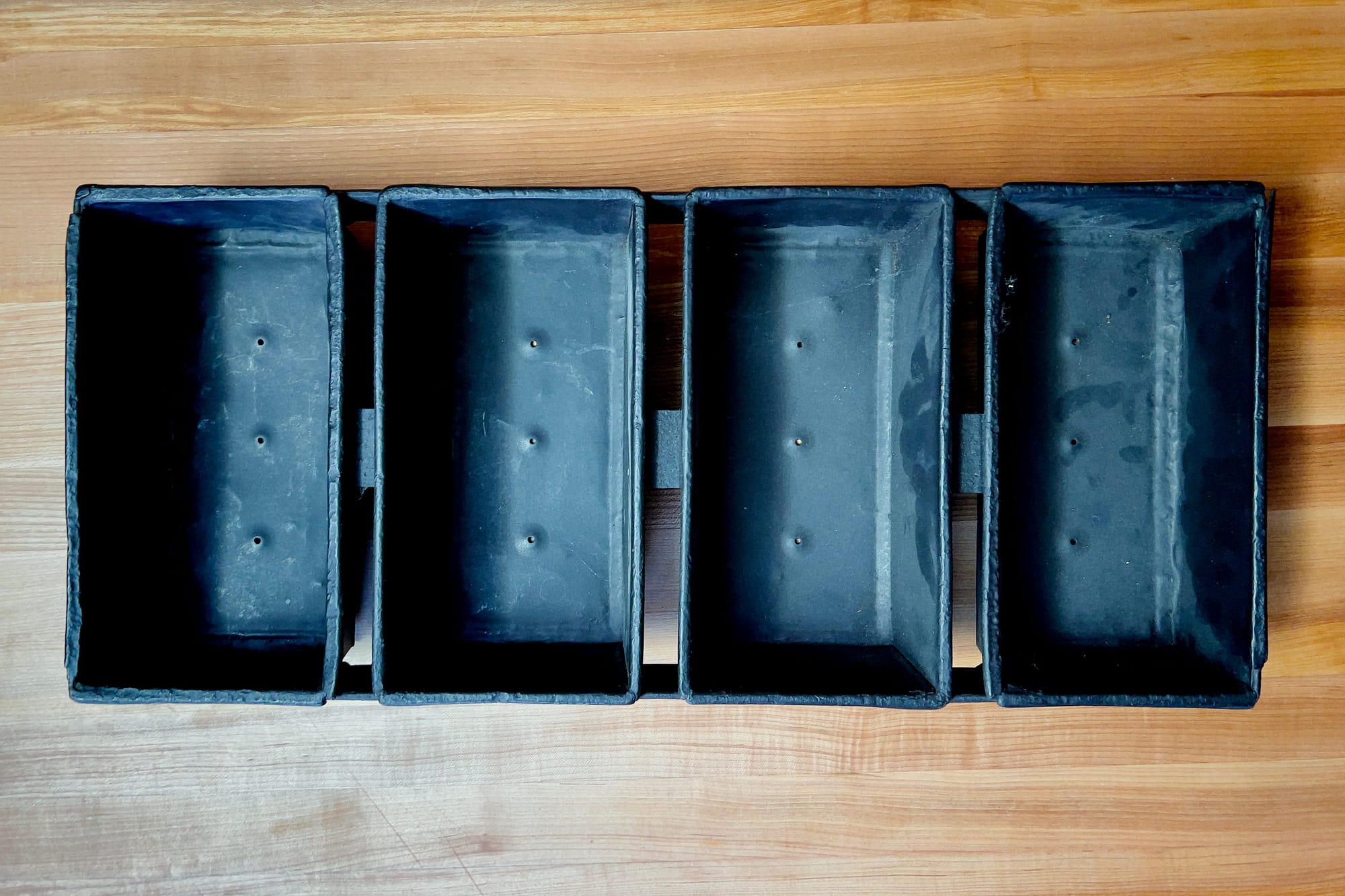Size Matters
On loaf and other pans

Table of Contents

On our way out of town from Norwich this past weekend, I scored a 4-pan strap loaf pan (meaning 4 pans attached together by metal straps) at a consignment store for a mere twenty-five bucks. I think it is an antique, but either way $25 is a good deal on a one of these babies:

The thing barely fits in my oven, and I don’t bake four pan loaves at a time very often, but nevertheless I’ve coveted one ever since I saw that the cool kids at Starter Bread in Portland, Oregon use them:
I plan to put mine to use soon and will share results here when I do. In the meantime, the find reminded me that I’d been meaning to talk here about the relationship between the volume of various bread baking pans and dough amounts for awhile now.

As I have mentioned before, my favorite loaf pans are these ones from Rackmaster (available in the US from Pleasant Hill Grain), for a few reasons. One: I prefer a right-angled, square-sided loaf, both for aesthetic reasons and because they make for nicer sandwich slices. Two: They are about an inch taller than most other loaf pans, which means they prevent the loaf from mushrooming over the edges of the pan as it expands, which (again) is nice both for aesthetics and for sandwiching. And three (though Maine Grains doesn’t yet carry them): They come with matching lids, which allow you to make perfectly square pullman loaves, which…yada yada yada.
The dimensions of a mini pullman pan are 9 x 4 x 4 inches, while those of the “standard” loaf pan used by most people are 8.5 x 4.5 x 2.6 inches. Those numbers—and the two pans when set side-by-side—might seem pretty similar, but in practice the difference between them is actually quite dramatic, in part because the “standard” loaf pan is fluted and narrows to 7.5 x 3.5 inches at its base.
The only real way to compare these two pans is to look at their volumes, and when you do that the difference is obvious: The volume of the fluted pan is 1440 cubic centimeters (cm³), while that of the square one is 2250cm³, making it more than 1.5x larger in volume. (I’m sure there is a straightforward way to calculate the volume of irregularly-shaped objects like that pan, but math makes my head hurt, so I just figured it out the easy way: I filled the pan to the brim with water and weighed the water. Since 1g water = 1 cm³, there’s no math necessary.)
Since I use the pullman pans myself, my recipes are tailored to make the most of their extra legroom. Which means that the same doughs end up cramped if put into smaller pans, and the loaves tend to crawl out of the pans once baked. I could scale my recipes down to fit into smaller pans, but a) people have lots of different pans, and b) some recipes, especially those that contain annoying-to-divide eggs, are a challenge to scale down easily.
Instead, I decided to create this chart (which is also included in my soon-to-ship Bread Baker’s Pocket Companion booklet):

It describes the dimensions, volume, and (my) recommended dough amounts for all of the most commonly-used pans I could think of, rectangular or round, flat or tall (most of which are depicted in the photo up top). The recommended dough amounts are based upon low-density doughs like brioche or white sandwich bread, and amount to 0.333g/cm³. (I explain this in the booklet too, but with more dense doughs like whole-grain ones, the number is closer to 0.444g/cm³, or about 1.33x the numbers listed.) These numbers are guidelines, mind you, not hard and fast rules, though they should be useful to determine whether a recipe should work in your particular pan, or what dough weight to aim for when developing a recipe meant to go in a pan of that size.
Now that I have this chart, I plan to specify the size of pan I intend any particular recipe to use. So what do you do if your pan is smaller than the one a recipe calls for? Just use the chart to determine how much dough you should put into it, and then make a bun or two with the leftover to eat as a baker’s treat!
—Andrew
wordloaf Newsletter
Join the newsletter to receive the latest updates in your inbox.




